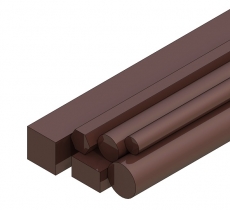
Material
Questions and Answers
Class 20 material is a designation of the Resistance Welding Manufacturers Alliance (RWMA). It describes a copper base material with high conductivity and good strength, similar to Class 2. In addition it has better resistance to annealing and may have less tendency to stick to the work piece. Class 20 is most often used to weld galvanized materials.
Class 3 material is a designation of the Resistance Welding Manufacturers Alliance (RWMA). It describes a group of copper alloys with excellent strength and good electrical conductivity. Class 3 is often used to weld stainless steel, nickel alloys and other highly resistive - strong materials that require high weld forces.

Class 3 Bar Stock
Class 2 material is a designation of the Resistance Welding Manufacturers Alliance (RWMA). This is a group of copper alloys with high strength and electrical conductivity. Class 2 is the most used material in the resistance welding industry. As electrodes it is used for welding bare and coated steels.

Class 2 Bar Stock
Class 1 material is a designation of the Resistance Welding Manufacturers Alliance (RWMA) which describes a group of copper alloys with good strength and high electrical conductivity. Class 1 is often used to weld aluminum and other good conductors like brasses and bronzes which require high weld currents.

Class 1 Bar Stock
The proper electrode material can be determined from published weld schedules based on the work pieces being spot welded. These weld schedules can be found in AWS Standard C1.1, Recommended Practices For Resistance Welding and RWMA The Resistance Welding Manual. Your electrode supplier is another source. Spot welding requires a few initial decisions to be made to set up a good welding process. Most of these evolve around pressure, current and time.
Page 2 of 2
Have a Question?
Do you have a question that is not covered in our knowledgebase? Do you have questions regarding the above article? Click here to ask the professor.
